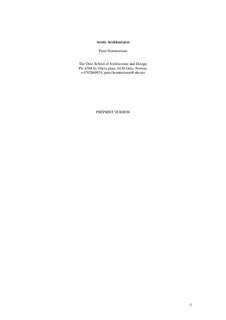| dc.description.abstract | In 1968, the British/Swedish architect Ralph Erskine published an article ‘Architecture and town planning in the north’ in this journal, in which he called for a particular Arctic approach to the design of buildings and cities that is distinct from mainstream architecture due to conditions such as harsh climate, resident indigenous or sparse population and remoteness. One hundred years after his birth (in 1914), Erskine is still considered the authoritative ‘Arctic architect’, and his approach is paradigmatic among many architects dealing with the built environment in the Arctic, sub-Arctic and northern regions. However, a study of the literature on architectural practice and the built environment in the north reveals a number of varying conceptions of Arctic architecture. These different perspectives are social in nature and construct the architectural technologies, the natural environment and society in different configurations. This article finds that architectural discourses and readings of the Arctic change under the influence of social, cultural, political and architectural paradigms. The perspectives identified in the article are seen to be critical supplements to Erskine’s utopian approach to developing new sustainable forms of urbanism and architecture in the Arctic. They also reveal that new conceptions do not necessarily replace previous ones but often overlap and place earlier ideas into fresh concepts and that certain conceptions appear to perpetuate over the decades, such as the Arctic as an ‘empty space’. The thinking on Arctic futures is, in many ways, trapped in certain modernist and utopian modes, and this article contributes to widening the range of possible relationships between people and the Arctic environment, using architecture as an aperture. | |
